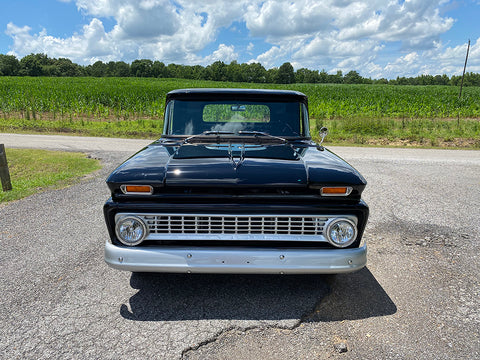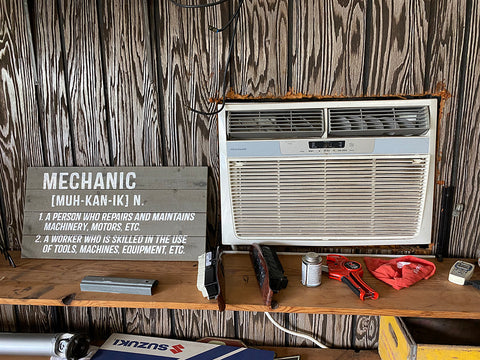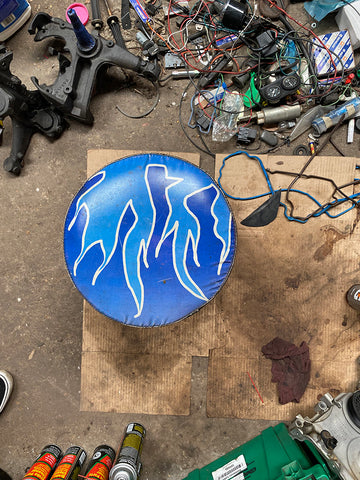Queens of the Road

For Love or Money, Women Are a Driving Force in American Automotive and Transportation Industries
Words by Sarah Carter
“The grease stain just won’t come off,” laughed Allyssa Bryant, pointing to the light gray half-moon on her forearm; the stain was offset by her delicate gold bracelet. I wouldn’t have seen it if she hadn’t pointed it out. Otherwise, Bryant looked weekend ready–très chic in black jeans, a white tee, and mirrored aviators.
As we chatted between rows of cars at a Friday night cruise-in, I learned the following:
The stubborn stain came from a high-performance engine in Aberdeen, Mississippi. The gold bracelet was Kendra Scott. Bryant, the nineteen-year-old future motorsports engineer with the grease-stained forearm, is from northwest Alabama—Winfield to be exact.
I live in Nashville and write about trucks. On a recent trip to visit my aunt Lynn Hughes, a long-time Winfield resident, she told me I just had to meet Allyssa. At the time, Bryant had just graduated from high school, completed restoration on her 1963 Chevy C/K 10, and was considering University of North Carolina Charlotte’s Motorsports Engineering program.

It was a happy coincidence that the cruise-in occurred the same weekend I was able to schedule a trip back to meet Allyssa and her family. And while I spent my afternoon driving—OK, driving and snacking—Allyssa was busy fine-tuning an engine with her mentor Robert Brown of Brown Engineering. Here’s what they accomplished in the span of my three-and-a-half-hour drive:
- Mounting an engine on a stand in a room with reinforced walls and bulletproof glass
- Starting said engine remotely
- Listening to the engine purr from the safety of their observation chamber
- Entering the chamber to listen to the engine even more closely
- Making adjustments to soup up the engine even more
“We went in there with a stethoscope to make sure it was making all the right sounds,” said Allyssa, pulling up a video on her phone to show me where she and Brown listened.
As we talked, Bryant’s gloss-black Chevy truck glowed behind her in the last golden light of the summer evening. The paint job was even shinier than her aviators—so shiny I took a selfie in its reflection.
“I washed it twice in 24 hours when we got it back [from a repair],” said Allyssa while I selfied. Bryant, brother Corbin, and dad Chad have been working on the truck since she was in middle school, with the goal of having it finished by her senior year. She wasn’t so thrilled when Chad brought it home for the first time though.
Pointing to a rusted-out truck in the cruise-in line (think Mater from Pixar’s Cars), Chad Bryant explained, “The truck over there that was meant to look rough—it [the C/K 10] was rougher than that, and it wasn’t meant to look that way. She hated it.”
When he brought it home, Chad had a clearer vision of what the Chevy could look like because he’s had a lot more experience bringing vehicles back to life. He owns Bryant Automotive, also in Winfield, and has worked as an automotive instructor at Bevill State Community College for over fifteen years.
In addition to the countless cars he’s worked on, Bryant still has the Ascot Blue 1971 Chevelle that he and his dad brought back to life when he was just 14 years old. “When everything else in the yard was broken,” said Chad, “I could always jump in this one and go.”
Allyssa caught the vision for her own fixer upper by doing just that—fixing it up. “She and Corbin built the engine,” said Chad. “Allyssa was probably twelve? She wasn’t very old. I physically set the heavy parts on there, but they did everything else.”

The time and sweat equity Allyssa invested came back to her in success. Before she could legally drive alone, Allyssa entered her first service competition. She was the only girl in her category, Motorcycle Service Technology, at the SkillsUSA Competition. She brought her own “cheater” blocks of wood for the tire change (since she was smaller than the other participants). When all was said and torqued, she earned third place.
Bryant has been increasingly successful in the field. In addition to restoring her truck, she placed Top 10 at the Wyatt Spann Memorial Car show in 2021, works weekends at a drag racetrack, completed her machine tool technology certificate at Bevill State in December 2021, and is currently learning to weld—she even got a fancy new hood for Christmas.
Allyssa hails from a long line of women in transportation. Maternal great-grandmother Bobbie Jean Dodd worked in a sewing plant for nineteen years before running Dodd Truck Parts in Eldridge, Alabama, with her husband, Hoyt Dodd. Dodd also served a thirty-six-year mayoral term for the town, the longest tenure of any mayor in Walker County.
Allyssa’s maternal grandparents, Gary and Martha Dodd, had their first date at Jack’s [Hamburgers] at a nearby truck stop when Gary was on a long-haul run. Martha often rode shotgun on Gary’s runs during their courtship. Later, Allyssa and her brother would ride shotgun too, often getting to spend the night in the sleeper cab.
Allyssa’s mother, Lisa, is an avid race fan and motorcycle enthusiast—she was once the owner of a pink crotch rocket.
* * *
Allyssa’s natural talent, hard work, and family support continue to move her toward her dream of being a motorsports engineer. But for an increasing number of American women, the financial promise of the transportation industry itself is giving them the support they need.
According to the Bureau of Labor Statistics in 2020, the percentage of female “driver/sales workers and truck drivers” in America is 7.8 percent of 3,364 total drivers—so, 262,392. Though this category includes a wide swath of drivers (from long-haul to delivery) and covers clerical work related to driving (orders, delivery payments, etc.), this is still an 88 percent increase since the BLS’s 2010 report.
A comparison of the BLS’s 2015 and 2020 figures also shows an increase in the percentage of women in two more categories: “automotive body and related repair” and “heavy vehicle and mobile equipment service technicians and mechanics.”

But the growing presence of women in the automotive and transportation industry is visible in more than just numbers. The list of female long-haul truck drivers with a TikTok channel is astounding, and this content is not only educational but also entertaining and makes space for other women in the field to connect.
And as more women move into this predominantly male space, new female-led organizations offer opportunities to build community, each in slightly different ways.
Women in Trucking Association Inc., a nonprofit established by Ellen Voie in 2007, is one of the most well-known organizations. Its mission is to encourage the employment of women in the industry, address obstacles to their success, and celebrate the success of female trucking pioneers. The organization currently gives two major annual awards encouraging advancement in the field: “Influential Woman in Trucking” and “Distinguished Woman in Logistics.”
Voie has also partnered with the Girl Scouts to provide opportunities for girls to learn about the role trucking plays in their daily lives. These “Trucks Are for Girls” events give scouts a chance to drive a simulator, get a tour of a truck cab, and more. As of today, at least 1,690 girls have earned their transportation patch, which features a blue long-hauler driving across a Kelly green background.
Desiree Wood’s Real Women in Trucking Inc. (est. 2013) aims to support female drivers through outreach programs, continuing education, advocacy, mentoring, networking, and ongoing support to promote retention, encouragement, and unity between both new and seasoned female drivers.
Sharae Moore’s S.H.E. Trucking LLC (2014) offers members classes, networking, a free e-book, opportunities for consulting, and even a podcast.
Cheryl Lynn Bean’s Ladies of Hawaii Truckin’ (est. 2016) offers ways for local drivers to connect and communicate about challenges specific to island driving.
The road poses specific challenges for female drivers, and though they have plenty on their plates, supporting each other is a recognizable value in the emerging culture of female trucking organizations.
* * *
Back at the cruise-in, when I asked Chad Bryant if he intentionally encouraged Allyssa to pursue automotive work, he responded, “Just whatever she wants to do. “This is not cut out for everybody, and I get that.”
Still, Chad has consistently had at least one female student in his automotive class most semesters for the past fifteen years. “When I’m recruiting, I say, ‘Whatever you’re interested in, doesn’t have to be my program, go into [that]. Let me help you get there.’”
Under the hood or on a run, for love or financial necessity, more women are moving into the driver’s seat, effectively navigating barriers so that others can too.




